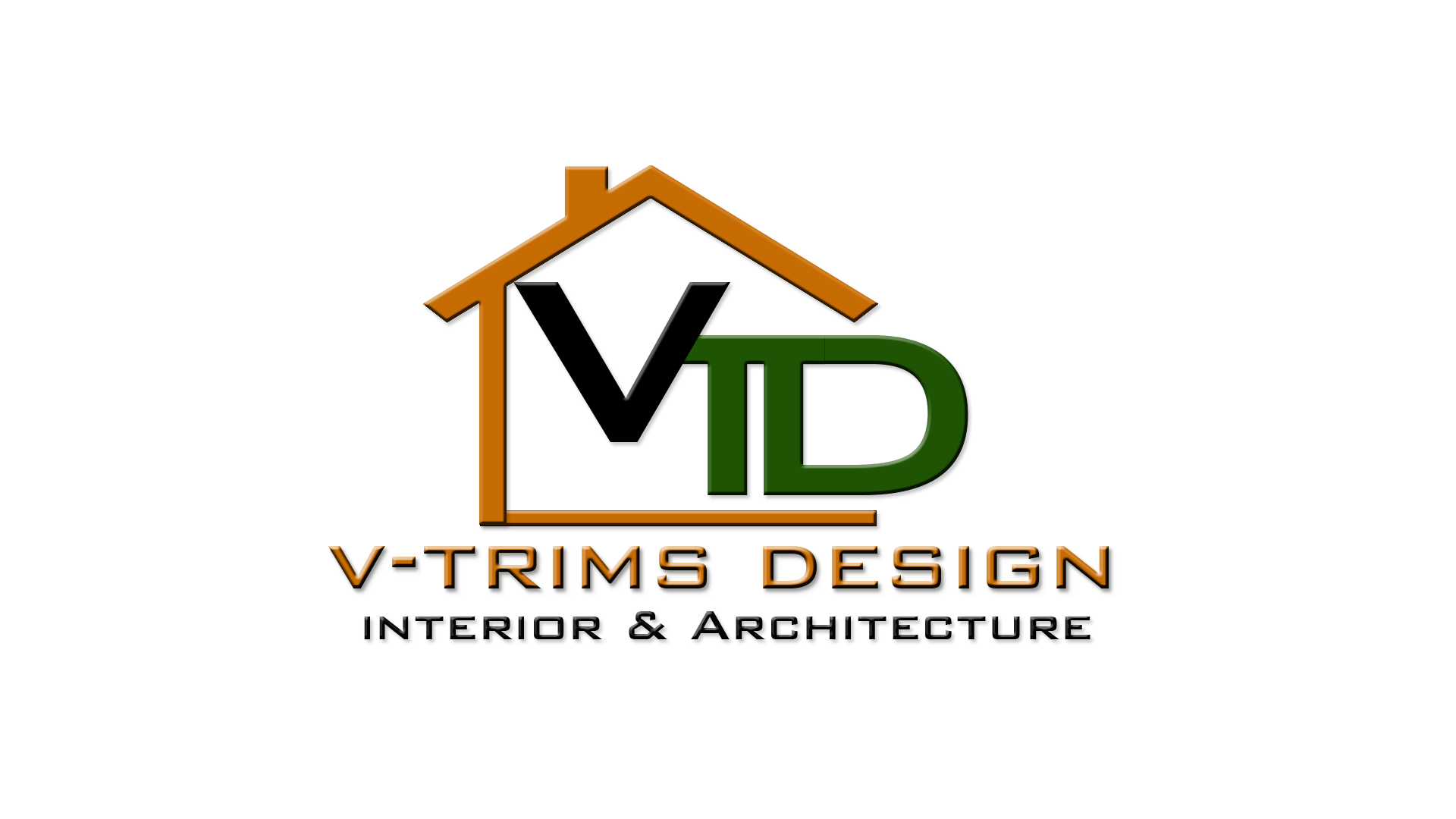NIKHIL GAMING.
2 months ago
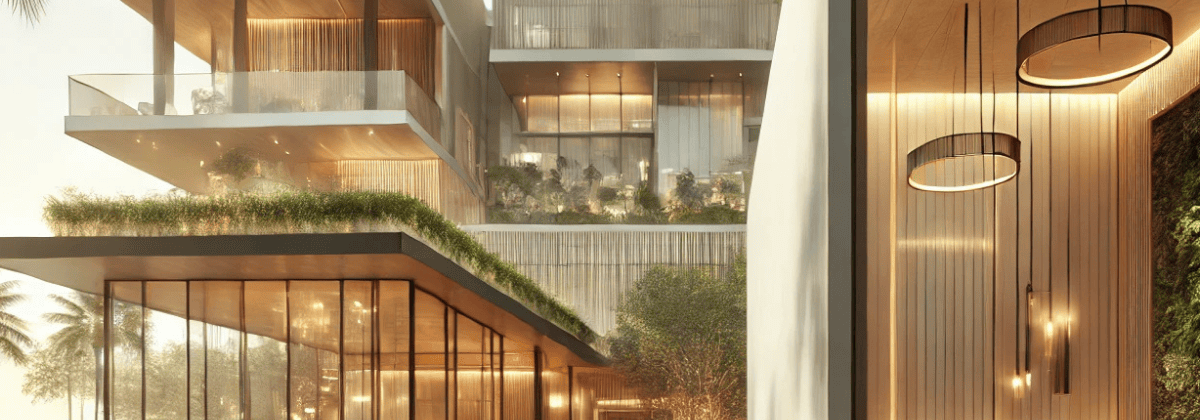
Hospitality architecture transcends conventional building design; it orchestrates sensory and spatial experiences that resonate with guests on a profound psychological level. Whether designing a metropolitan boutique hotel, a sprawling luxury resort, or a Michelin-starred restaurant, architects must integrate aesthetic appeal, operational efficiency, and emotional engagement to create enduring and memorable spaces. But what methodologies and theoretical frameworks underpin these sophisticated design processes?
Hospitality architecture is a confluence of environmental psychology, human-centric design, and advanced materiality. The discipline necessitates an intricate balance between form and function, where spatial arrangements are not only visually compelling but also intuitively navigable and emotionally evocative.
From an experiential perspective, architectural elements such as lighting, acoustic modulation, and spatial proportions shape user perception and influence behavior. For example, a hotel’s lobby—often the guest’s first physical encounter with the brand—must be an emblem of the establishment’s identity, seamlessly blending comfort, elegance, and efficiency. Similarly, the interplay of transparency and enclosure in resort architecture dictates the degree of engagement with the surrounding environment, reinforcing the concept of escapism and sanctuary.
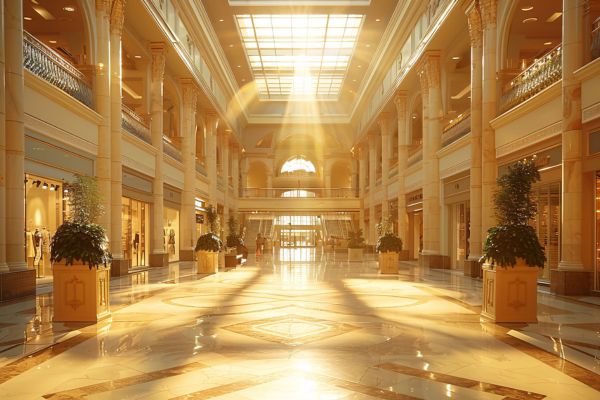
The typology of hotels is diverse, encompassing everything from minimalist urban accommodations to expansive, multi-functional luxury resorts. Regardless of scale, successful hotel architecture prioritizes both guest experience and operational fluidity.
A hotel lobby functions as a transitional space, bridging the external environment with the curated interior realm. The spatial syntax of this area must not only facilitate wayfinding but also create a strong emotional imprint through textural diversity, sculptural elements, and dynamic lighting schemes. High atriums, reflective surfaces, and warm-toned ambient lighting can evoke grandeur, while biophilic integrations such as vertical gardens promote relaxation and psychological well-being.
Guest rooms are microcosms of the broader hospitality experience, demanding meticulous attention to ergonomics, technological integration, and spatial sequencing. The progression of smart room technologies, from IoT-enabled climate control to AI-powered room customization, is redefining personalized hospitality. Additionally, sustainable design principles, such as modular furniture and low-VOC materials, are influencing contemporary hotel interiors, aligning with the industry’s shift towards environmental responsibility.
Modern hospitality design extends beyond the private domain into communal areas where interaction and relaxation coalesce. Rooftop bars, wellness spas, and immersive lounges must be designed to facilitate both individual retreat and social engagement. The spatial programming of these areas involves strategic zoning to accommodate varying intensities of activity while maintaining an overarching thematic continuity.
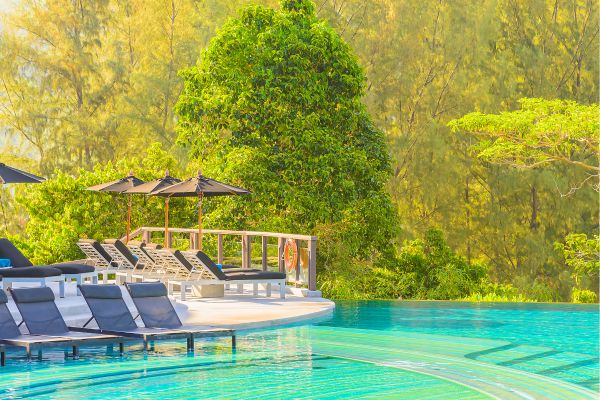
Resorts epitomize the synergy between architecture and landscape, necessitating a design philosophy that enhances the natural environment rather than competes with it.
Resort architecture often employs fluid spatial transitions, dissolving the demarcation between interior and exterior realms. Expansive glazing, retractable partitions, and open-air courtyards allow for an uninterrupted visual and physical connection to the surroundings. By incorporating local materials and indigenous design motifs, architects reinforce a sense of place, fostering cultural and ecological authenticity.
The contemporary paradigm of hospitality architecture demands a shift from sustainability to regenerative design—an approach that seeks not only to minimize environmental impact but also to contribute positively to ecosystems. Passive cooling strategies, photovoltaic facades, and permaculture-driven landscape design exemplify the progressive ethos of next-generation resort architecture.
Luxury resorts increasingly prioritize hyper-personalized experiences, where architectural design serves as a medium for exclusivity. Villas with private infinity pools, bespoke wellness pavilions, and AI-assisted concierge services underscore the movement towards individualized, immersive hospitality. These spaces are crafted with an acute awareness of psychological refuge, ensuring a profound sense of escapism and indulgence.
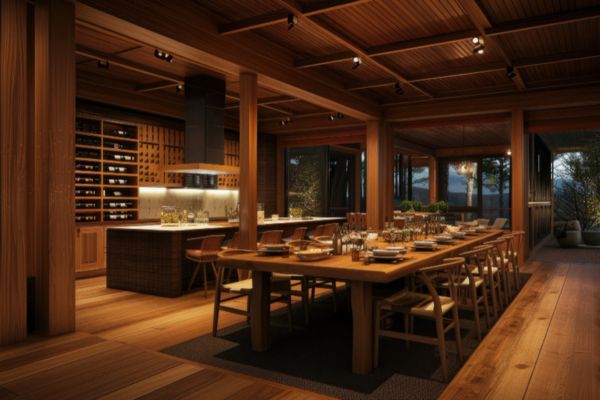
Restaurants are theatrical environments, where design elements must augment the culinary narrative while optimizing functionality.
A well-orchestrated restaurant layout must accommodate seamless circulation patterns for both patrons and staff. The spatial hierarchy—from entrance sequences to seating configurations—should intuitively guide guests while allowing for operational efficiency behind the scenes. The adjacency of kitchens, service stations, and storage areas is meticulously calibrated to enhance workflow and minimize disruptions.
Illumination and soundscaping are pivotal in shaping the dining atmosphere. Dynamic lighting—achieved through adjustable luminance levels and color temperature modulation—can evoke different moods, from intimate fine dining to high-energy gastro-bars. Similarly, acoustically optimized interiors, employing materials such as fabric wall panels and timber baffles, mitigate noise pollution and enhance auditory comfort.
Restaurants that leverage immersive design principles—integrating multisensory cues such as scent diffusion, textural contrasts, and curated soundscapes—heighten the overall dining experience. Whether through a hyper-minimalist aesthetic or an ornate, historical revival, the architectural narrative must align with the brand’s culinary identity.
Technology is revolutionizing the hospitality sector, embedding intelligence into the built environment. The advent of AI-driven automation, digital concierge services, and biometric security systems is redefining guest interactions. Furthermore, augmented reality (AR) interfaces offer guests virtual explorations of facilities, while machine-learning algorithms enhance predictive maintenance, reducing energy consumption and operational downtime.
The evolution of hospitality architecture is characterized by an increasing emphasis on bespoke experiences, sustainable interventions, and technological synergies. The growing demand for boutique accommodations signals a departure from standardized hotel chains, favoring highly curated, locally embedded establishments. Likewise, the adaptive reuse of heritage buildings into contemporary hospitality venues aligns with the industry’s sustainability directives while preserving cultural narratives.
At V-Trims Design, we specialize in crafting unparalleled hospitality environments that blend innovation with timeless appeal. Whether conceptualizing a high-end urban hotel, a secluded resort retreat, or an avant-garde restaurant, our approach is rooted in meticulous research and forward-thinking strategies. Partner with the best architecture firm in Lucknow for exceptional hospitality design.
5 months ago
VTRIM Design isn’t just designing buildings — they’re designing experiences, stories, and lifestyles. Highly recommended for anyone who values quality, aesthetics, and integrity in architecture.
6 months ago
Gajab ke designer h mera ghar bnaya h jabse roz dekh ke unhi ko yad krta hu kya bnaya h.
6 months ago
Best architecture firm in Lucknow. Exceptionally good in terms of designing and service standards. Professionalism and dedication towards each project is outstanding. I Wish them great success in future. Highly recommended go for v-Trims design
6 months ago
VTRIM Design isn’t just designing buildings — they’re designing experiences, stories, and lifestyles. Highly recommended for anyone who values quality, aesthetics, and integrity in architecture.
6 months ago
Best interior designer in lucknow and best creativity work in interior design
6 months ago
I'm painter and i have been working for long time with v-trims design . This fir is done many attractive projects
6 months ago
"VTRIMS Design truly listens to your needs and offers creative solutions. Their team is very responsive and skilled. Highly professional."
6 months ago
Excellent company.The team is young,talented,and very passionate about design
6 months ago
"If you're looking for modern and elegant interiors, VTRIMS Design is the go-to place. Loved their approach, especially the 3D visuals before execution."
6 months ago
⭐⭐⭐⭐⭐ "From concept to completion, everything was handled with perfection. The team is young, talented, and very passionate about design."
6 months ago
⭐⭐⭐⭐⭐ "Loved working with them! My kitchen and dining space look like something out of a magazine. Superb craftsmanship."
6 months ago
It's nice company work is very fast trustable company Clint always happy interior design so attractive and amazing team all good❤️❤️
6 months ago
⭐⭐⭐⭐⭐ "Very professional team! They handled my 3BHK interior project beautifully. Timely delivery and unique designs. Thank you VTRIMS Design."
6 months ago
"Very professional team! They handled my 3BHK interior project beautifully. Timely delivery and unique designs. Thank you VTRIMS Design."
6 months ago
"Brilliant design, smooth execution and a truly professional team. They turned our vision into a beautiful, functional space we know call home . Highly recommended! "
6 months ago
V Trims is a firm with young and dynamic Architects who are very innovative in designing. They make very good looking contemporary structures with clean finish
6 months ago
Exceptional creativity and execution! The design team perfectly understood our vision and brought it to life with style and functionality. Professional, detail-oriented, and truly passionate about their work. Highly recommended for anyone looking to elevate their space!
6 months ago
They are doing very well construction finishing as welll best wishes for future endeavours
6 months ago
it's too good . There way of talking there designs everything is totally wonderful you all will like their presentation
6 months ago
First of all thanks for V trims design team provided good quality of work unique design i have batter expression with them this credit total goes to Ar vinod Chauhan sir
6 months ago
Just wanted to say a sincere thank you for all the work you have done for us in creating our amazing new space. We love it and were continually impressed by your professionalism, attention to detail, care and the support you provided us during this project. You made the process so easy for us and we are very grateful.
6 months ago
The man behind V-Trims is wow....Hire & give your dream home or Project a wow !!
6 months ago
Keep it up, you’re doing a great job in building architectures. All the best.
6 months ago
"V Trims Design Company is a game-changer in the architectural design field, delivering innovative and functional designs that exceed expectations. Their expertise and attention to detail make them a top choice for any design project."
6 months ago
"Highly impressed every detail reflected thoughtful design and quality craftsmanship.
6 months ago
"Highly impressed with their creativity and professionalism! Good working company... 💪
6 months ago
"Highly impressed with their creativity and professionalism! The team delivered a perfect blend of aesthetics and functionality. Every detail reflected thoughtful design and quality craftsmanship.
6 months ago
Every detail, from the foundation to the finishing, shows top-notch craftsmanship of V-Trims Designs.
6 months ago
"Very professional team! They handled my 3BHK interior project beautifully. Timely delivery and unique designs. Thank you VTRIMS Design."
6 months ago
V-trims Design (Architectural & Interior Design) deals all types of building design, interior design, survey, layout plans for plottings. They provide best quality service at affordable price in U.P.
6 months ago
V-Trims provides exceptional service with a team that's responsive and professional. Their attention to detail and commitment to quality make them a top choice for Architect and interior design.
6 months ago
The firm and its supporting team are genuinely sincere and dedicated.
6 months ago
A really great firm with amazing designs with state of the art features. Decent cost and one of the most disciplined and dedicated team an individual as a client can ask for with very smooth execution.
6 months ago
Sir your work is very beautiful The interior design you have done is beyond comparison. The elevations you have made, the plantation you have done and your team working is very good. I pray to Allah that you get a lot of success.
6 months ago
The trendsetting and innovative architectural capabilities of Vinod and his team set them apart as leaders in the industry.
6 months ago
They managed the project effectively, keeping us on schedule and within budget." or "We were particularly impressed with their ability to adapt to unexpected challenges." "They skillfully addressed any challenges that arose during the project, finding creative solutions."
6 months ago
One of the best architect firm in lucknow There is a lot of cleanliness in their work, all the staff is experienced and well trained, I will always recommend V trims to everyone
6 months ago
"From concept to completion, everything was handled with perfection. The team is young, talented, and very passionate about design."
6 months ago
Very good experience with v-trim team and good supportive team for all the movement to built your dream home...Thanks v-trims ...🙏🙏
6 months ago
Top best Architect for lucknow please contact to V trims Design for every type of Buildings design & Interior/Exterior designing......
6 months ago
Here's a 5-star rating review for V-Trims Design | Architect & Interior: ⭐⭐⭐⭐⭐ Exceptional Design and Professionalism! I had an amazing experience working with V-Trims Design. Their attention to detail, innovative ideas, and seamless execution truly set them apart. From the initial consultation to the final touches, their team was professional, creative, and responsive to every need. They transformed my space into something both beautiful and functional, exceeding my expectations in every way. Highly recommended for anyone looking for top-tier architectural and interior design services!
6 months ago
"VTRIMS design transformed my home into a dream space! Their attention to details and creativity blew me away . Highly recommended for premium interior design in lucknow .
6 months ago
"VTRIMS Design transformed my home into a dream space! Their attention to detail and creativity blew me away. Highly recommended for premium interior design in Lucknow."
6 months ago
"If you're looking for modern and elegant interiors, VTRIMS Design is the go-to place. Loved their approach, especially the 3D visuals before execution."
6 months ago
Very professional team! They handled my 3BHK interior project beautifully. Timely delivery and unique designs. Thank you VTRIMS Design.
8 months ago
"One of the rare firms that balance creativity, technology, and budget without compromising quality. Absolutely worth it!"
11 months ago
Top-Tier Architectural Expertise in Lucknow! Vtrims Design is undoubtedly one of the best architecture firms in Lucknow, offering innovative and aesthetically stunning designs that perfectly blend functionality with creativity. As a leading architect in Lucknow, their team excels in residential, commercial, and interior design projects, delivering outstanding results tailored to client needs. Their expertise in modern architectural solutions, space planning, and sustainable designs sets them apart. Whether you're looking to design a luxurious home, a contemporary office, or a commercial space, Vtrims Design ensures every project is executed with precision and excellence. If you're searching for a trusted and experienced architect in Lucknow, look no further than Vtrims Design. Their professionalism, attention to detail, and commitment to quality make them the go-to choice for architectural services. Highly recommended!
V-Trims Design is an architectural design and construction company in Lucknow founded by young entrepreneurs with a love of design and the belief that every home should be designed to impress and that every person should have a designer lifestyle.
